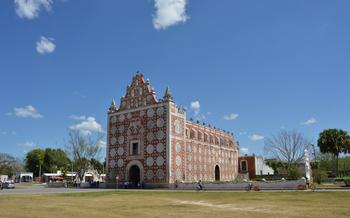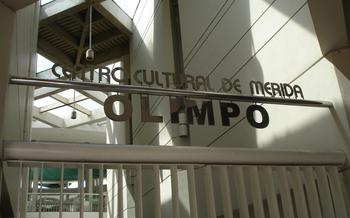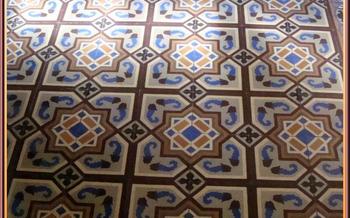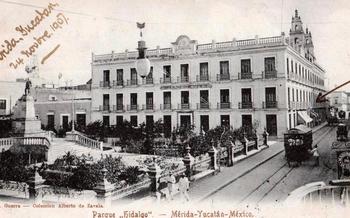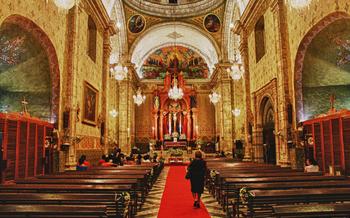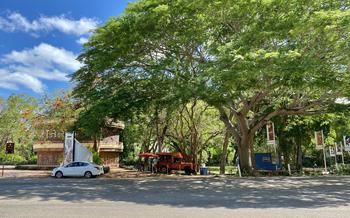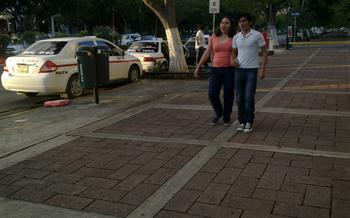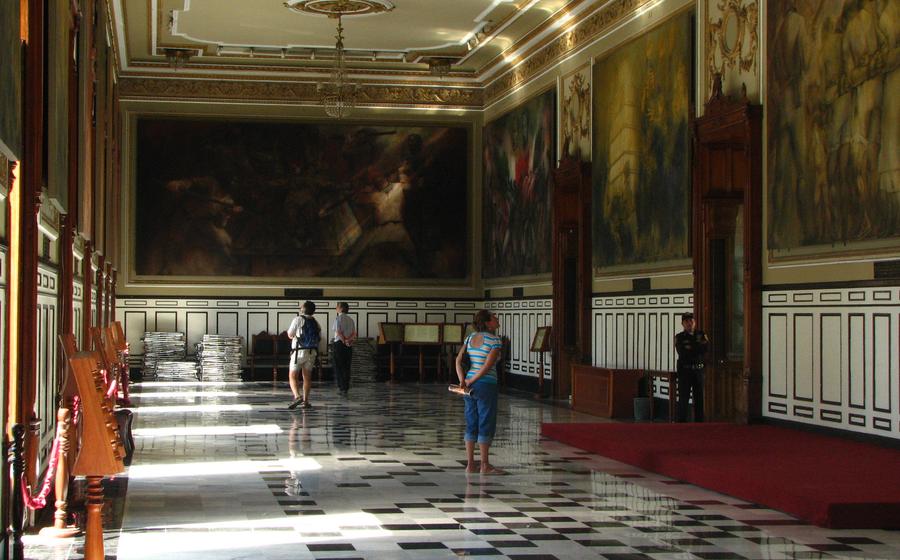
Palacio de Gobierno
- Merida: A Journey Through History
- Artifacts and exhibits showcasing Merida's past
- Exploring the Governor's Office: A Glimpse into Power
- The Sala de los Pasos Perdidos: Where History Unfolds
- The Grand Staircase: A Masterpiece of Architecture
- The Throne Room: A Seat of Power and Prestige
- The Reception Room: A Place for Diplomacy and Meetings
- The Conference Room: Where Decisions are Made
- Official Events and Ceremonies: Witnessing History in Motion
- Photography and Videography: Capturing the Palace's Grandeur
- Accessibility and Facilities: Ensuring a Comfortable Visit
Merida: A Journey Through History
In the heart of Merida, a testament to the region's rich history. Built in the 19th century on the site of a former Franciscan monastery, this grand edifice serves as the seat of the state government of Yucatan and is a symbol of the city's enduring spirit. Step inside this architectural masterpiece, and you'll be transported back in time, surrounded by artifacts and exhibits that tell the captivating story of Merida's past.
The Palacio de Gobierno is not just a building; it's a living testament to the city's evolution, from its humble beginnings to its rise as a thriving cultural and economic center. It's a place where history unfolds, where decisions are made, and where the future is shaped.
Artifacts and exhibits showcasing Merida's past
The Palacio de Gobierno houses a remarkable collection of artifacts and exhibits that trace the rich history of Merida and the Yucatan region. Visitors can embark on a journey through time as they explore ancient Mayan relics, colonial-era documents, and artifacts from the Mexican Revolution. The museum's collection includes pottery, textiles, sculptures, paintings, and furniture, each piece carefully curated to tell the story of Merida's past. Interactive displays and educational programs further enhance the visitor experience, providing deeper insights into the region's cultural heritage. Whether you're a history buff, an art enthusiast, or simply curious about Merida's past, the Palacio de Gobierno offers a treasure trove of discoveries waiting to be explored.
Exploring the Governor's Office: A Glimpse into Power
The Governor's Office within the Palacio de Gobierno holds a significant place in the history and governance of Merida. It has been the seat of power for many notable governors who have shaped the city's development and progress. Each governor has left their own mark on the office, contributing to its rich legacy.
The office itself is a testament to the power and prestige of the governor's position. Its grand architecture, intricate décor, and carefully chosen furnishings reflect the importance of the role. Visitors to the office can admire the ornate chandeliers, elegant furniture, and impressive artwork that adorn the space.
Access to the Governor's Office for visitors is typically restricted due to its official nature. However, guided tours may be available on certain days or during special events, offering visitors a unique opportunity to step into the heart of political power in Merida.
The Sala de los Pasos Perdidos: Where History Unfolds
Within the Palacio de Gobierno lies the majestic Sala de los Pasos Perdidos (Hall of the Lost Steps), a grand chamber that has witnessed the unfolding of Yucatan's rich history. Named after the echoing footsteps that seem to linger within its walls, this hall serves as a testament to the region's past and present.
The walls of the Sala de los Pasos Perdidos are adorned with stunning murals, each depicting a pivotal event in Yucatan's history. From the arrival of the Spanish conquistadors to the declaration of independence, these murals narrate the region's journey through time. The hall's architectural features, including its high ceilings and arched windows, create an atmosphere of grandeur and awe.
Known for its exceptional acoustics, the Sala de los Pasos Perdidos has hosted countless official ceremonies, speeches, and events. The hall's resonant qualities have allowed the voices of leaders, dignitaries, and ordinary citizens to reverberate through its chambers, leaving an indelible mark on its history.
Visitors to the Palacio de Gobierno are granted access to this hallowed hall, where they can immerse themselves in Yucatan's captivating history. Whether admiring the intricate murals, appreciating the architectural details, or simply soaking in the atmosphere, the Sala de los Pasos Perdidos offers a glimpse into the heart of this vibrant region.
The Grand Staircase: A Masterpiece of Architecture
The grand staircase of the Palacio de Gobierno is a breathtaking architectural masterpiece that commands attention and admiration. Constructed in the 19th century, it is a testament to the skill and artistry of the Yucatecan craftsmen. The staircase features a double-helix design, with two separate staircases winding around a central column. This unique design creates a mesmerizing visual effect and allows for two-way traffic, making it both functional and aesthetically pleasing.
The staircase is adorned with intricate ironwork railings, which showcase the region's rich tradition of metalwork. The banisters are adorned with intricate scrollwork and floral motifs, adding a touch of elegance and sophistication to the overall design. Each step of the staircase is made of solid wood, polished to a high gloss, creating a sense of warmth and grandeur.
The symbolism of the grand staircase cannot be overlooked. The double-helix design represents the duality of power and justice, while the central column symbolizes the strength and stability of the government. The staircase is a reminder of the importance of justice and fairness in governance, and it serves as a fitting entrance to the seat of power in Yucatan.
Visitors to the Palacio de Gobierno are welcome to climb the grand staircase, experiencing its grandeur firsthand. It is a popular spot for photo opportunities, offering stunning views of the courtyard and the interior of the palace. Whether you are a history buff, an architecture enthusiast, or simply someone who appreciates beautiful things, the grand staircase of the Palacio de Gobierno is sure to leave a lasting impression.
The Throne Room: A Seat of Power and Prestige
The throne room is the most impressive chamber within the Palacio de Gobierno, serving as a grand stage for official ceremonies and events. Its opulent décor and exquisite furnishings reflect the power and prestige of the governor's office. The room's centerpiece is a majestic throne, intricately carved from mahogany and adorned with intricate gold leaf detailing. The throne is positioned on a raised dais, symbolizing the authority and sovereignty of the governor.
The walls of the throne room are adorned with grand oil paintings depicting historical scenes and portraits of notable governors who have shaped the destiny of Merida. A massive crystal chandelier hangs from the ceiling, casting a warm glow upon the room's opulent furnishings. The floor is covered in a rich burgundy carpet, adding to the room's grandeur.
The throne room is primarily used for official ceremonies, such as the inauguration of new governors, the swearing-in of cabinet members, and the signing of important documents. It also serves as a venue for special events, such as state banquets, diplomatic receptions, and award ceremonies.
Visitors to the Palacio de Gobierno are granted access to the throne room during guided tours. While photography is permitted, visitors are reminded to maintain a respectful demeanor and refrain from touching or leaning against the furniture. The throne room stands as a testament to the power and prestige of the governor's office, and it is a must-see for anyone interested in the history and politics of Merida.
The Reception Room: A Place for Diplomacy and Meetings
The reception room of the Palacio de Gobierno is a grand and elegant space where official meetings, diplomatic gatherings, and social events are held. Completed in the early 20th century, this room reflects the building's unique architectural style, blending colonial and neoclassical elements.
The reception room is adorned with intricate moldings, decorative columns, and a stunning chandelier. The walls are adorned with beautiful murals depicting scenes from Mexican history, adding a touch of cultural significance to the room.
This room has witnessed countless important discussions, negotiations, and agreements that have shaped the course of Merida and the Yucatan region. Notable figures from the world of politics, diplomacy, and business have graced this space, leaving behind a rich legacy of historical significance.
Visitors to the Palacio de Gobierno can request a guided tour of the reception room, where they will learn about its history, significance, and the events that have unfolded within its walls. Whether attending an official event or simply admiring its architectural beauty, the reception room offers a glimpse into the diplomatic and social life of Merida.
The Conference Room: Where Decisions are Made
The conference room within the Palacio de Gobierno holds a significant place as a hub for crucial decision-making and strategic discussions. This elegant and well-appointed space has witnessed the shaping of policies, the resolution of conflicts, and the charting of Merida's future.
History and Significance The conference room has been an integral part of the Palacio de Gobierno since its inception. It was designed to serve as a formal meeting place for government officials, where they could deliberate and make decisions that would impact the city and its people. Over the years, the room has hosted countless meetings, negotiations, and summits, leaving an indelible mark on Merida's history.
Architectural Features and Décor The conference room exudes an aura of authority and grandeur, reflecting its importance as a seat of power. The room's architectural features, such as the high ceiling, ornate moldings, and mahogany paneling, create a sense of formality and seriousness. The décor is understated yet elegant, with a large mahogany table surrounded by comfortable chairs.
Use of the Room The conference room is primarily used for official meetings and events. It serves as a venue for cabinet meetings, where the governor and his advisors discuss and make decisions on a wide range of issues affecting Merida. The room also hosts meetings with foreign dignitaries, business leaders, and other important guests.
Accessibility for Visitors While the conference room is primarily reserved for official use, visitors may have the opportunity to glimpse this important space during guided tours of the Palacio de Gobierno. The tours provide insights into the history and significance of the room, allowing visitors to appreciate its role in shaping Merida's destiny.
Official Events and Ceremonies: Witnessing History in Motion
The Palacio de Gobierno serves as a grand stage for official events and ceremonies that hold immense significance in Merida's political, cultural, and social fabric. These events offer a unique opportunity for visitors to witness history unfolding within the palace's majestic walls.
From presidential visits and diplomatic summits to state banquets and prestigious award ceremonies, the Palacio de Gobierno has seen it all. Each event is meticulously planned and executed, adhering to strict protocols that reflect the solemnity and importance of the occasion.
Visitors can catch a glimpse of these events by checking the palace's official website or inquiring at the tourist information center. Dress code and etiquette are essential for attending official events, so it's crucial to dress appropriately and behave respectfully.
Whether you're a history buff, a political enthusiast, or simply curious about the inner workings of government, witnessing an official event at the Palacio de Gobierno is an experience you won't soon forget. It's a chance to step into the heart of Merida's political landscape and observe history in the making.
Photography and Videography: Capturing the Palace's Grandeur
The Palacio de Gobierno's architectural beauty and historical significance make it a popular subject for photography and videography. While capturing the palace's grandeur through your lens is encouraged, there are a few guidelines to ensure respect and preservation of this cultural heritage site.
Permission is Essential: Before taking any photos or videos inside the palace, it's crucial to obtain permission from the appropriate authorities. This ensures that you comply with any restrictions or special considerations for certain areas or artifacts.
Respect the Privacy of Others: While capturing the palace's beauty, be respectful of visitors and staff members. Avoid taking photos or videos that may intrude on their privacy or disrupt ongoing activities.
Tripods and Lighting: Tripods and external lighting equipment are generally not permitted inside the palace. These accessories can obstruct walkways and damage delicate surfaces. Instead, utilize natural light and handheld photography techniques to capture the essence of the palace.
Flash Photography: The use of flash photography is prohibited in certain areas of the palace to protect sensitive artifacts from damage. Please adhere to the signage and guidelines provided by the staff.
Share Responsibly: Once you've captured your stunning shots, consider sharing them responsibly. Tag the Palacio de Gobierno in your social media posts and use relevant hashtags to promote and raise awareness of this cultural landmark. By sharing your experiences, you contribute to the preservation and appreciation of the palace's heritage.
Accessibility and Facilities: Ensuring a Comfortable Visit
For visitors with disabilities, the Palacio de Gobierno offers a range of accessibility features to ensure a comfortable and enjoyable visit. These include wheelchair ramps, accessible restrooms, and designated parking spaces. Guided tours in various languages, including English and Spanish, are available, providing visitors with an in-depth understanding of the palace's history and significance. For those with specific needs, the palace offers personalized assistance and services to enhance their experience.
Restrooms and drinking fountains are conveniently located throughout the palace, ensuring that visitors can stay refreshed and hydrated during their tour. Whether you're visiting independently or with a group, the Palacio de Gobierno has facilities and services to accommodate your needs.
